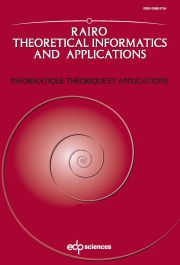Crossref Citations
This article has been cited by the following publications. This list is generated based on data provided by
Crossref.
Cadilhac, Michaël
Krebs, Andreas
and
McKenzie, Pierre
2013.
Algebraic Informatics.
Vol. 8080,
Issue. ,
p.
60.
Ibarra, Oscar H.
2014.
Descriptional Complexity of Formal Systems.
Vol. 8614,
Issue. ,
p.
5.
Figueira, Diego
and
Libkin, Leonid
2015.
Path Logics for Querying Graphs: Combining Expressiveness and Efficiency.
p.
329.
Ibarra, Oscar H.
and
McQuillan, Ian
2016.
The effect of end-markers on counter machines and commutativity.
Theoretical Computer Science,
Vol. 627,
Issue. ,
p.
71.
Castiglione, Giusi
and
Massazza, Paolo
2017.
On a class of languages with holonomic generating functions.
Theoretical Computer Science,
Vol. 658,
Issue. ,
p.
74.
Halfon, Simon
Schnoebelen, Philippe
and
Zetzsche, Georg
2017.
Decidability, complexity, and expressiveness of first-order logic over the subword ordering.
p.
1.
Massazza, Paolo
2017.
Implementation and Application of Automata.
Vol. 10329,
Issue. ,
p.
175.
Ibarra, Oscar H.
and
McQuillan, Ian
2018.
Reversibility and Universality.
Vol. 30,
Issue. ,
p.
357.
Cadilhac, Michaël
Krebs, Andreas
and
McKenzie, Pierre
2018.
The Algebraic Theory of Parikh Automata.
Theory of Computing Systems,
Vol. 62,
Issue. 5,
p.
1241.
Blondin, Michael
and
Raskin, Mikhail
2020.
The Complexity of Reachability in Affine Vector Addition Systems with States.
p.
224.
Czerwiński, Wojciech
and
Zetzsche, Georg
2020.
An Approach to Regular Separability in Vector Addition Systems.
p.
341.
Bednarczyk, Bartosz
and
Michaliszyn, Jakub
2021.
Foundations of Software Science and Computation Structures.
Vol. 12650,
Issue. ,
p.
82.
Baumann, Pascal
D’Alessandro, Flavio
Ganardi, Moses
Ibarra, Oscar
McQuillan, Ian
Schütze, Lia
and
Zetzsche, Georg
2023.
Foundations of Software Science and Computation Structures.
Vol. 13992,
Issue. ,
p.
240.
Hoffmann, Stefan
2023.
Developments in Language Theory.
Vol. 13911,
Issue. ,
p.
113.
Almagor, Shaull
and
Yizhaq, Omer
2023.
Developments in Language Theory.
Vol. 13911,
Issue. ,
p.
9.
Almagor, Shaull
and
Salgado, Ishai
2024.
Jumping Automata Must Pay.
Electronic Proceedings in Theoretical Computer Science,
Vol. 409,
Issue. ,
p.
19.
Almagor, Shaull
and
Yizhaq, Omer
2024.
Jumping Automata over Infinite Words.
Theory of Computing Systems,
Vol. 68,
Issue. 6,
p.
1572.
Cadilhac, Michaël
Ghosh, Arka
Pérez, Guillermo A.
and
Raha, Ritam
2025.
Parikh one-counter automata.
Information and Computation,
Vol. 306,
Issue. ,
p.
105322.
Erlich, Enzo
Grobler, Mario
Guha, Shibashis
Jecker, Ismaël
Lehtinen, Karoliina
and
Zimmermann, Martin
2025.
History-Deterministic Parikh Automata.
ACM Transactions on Computational Logic,
Vol. 26,
Issue. 3,
p.
1.

